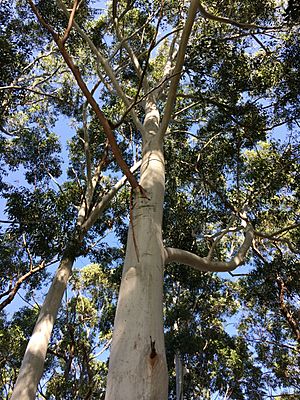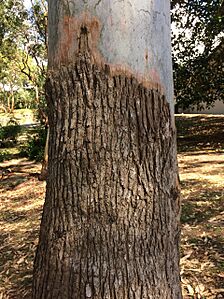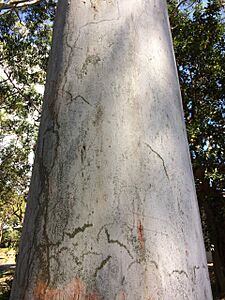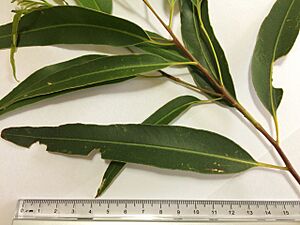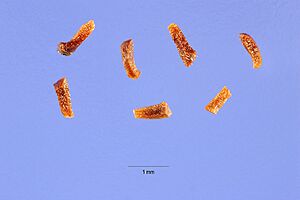Sydney blue gum facts for kids
Quick facts for kids Sydney blue gum |
|
|---|---|
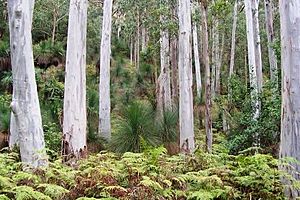 |
|
| Blue gum forest at Mount Cabrebald | |
| Scientific classification | |
| Genus: |
Eucalyptus
|
| Species: |
saligna
|
| Synonyms | |
|
|
The Eucalyptus saligna, often called the Sydney blue gum, is a type of tree. It grows in eastern Australia. This tree can be medium-sized or very tall.
Its trunk has rough, flaky bark near the bottom. Higher up, the bark is smooth. Its adult leaves are shaped like a spear or are slightly curved. The tree's flower buds grow in groups of seven, nine, or eleven. It has white flowers. Its fruit looks like a cylinder, cone, or cup.
Contents
What the Sydney Blue Gum Looks Like
The Sydney blue gum is a tall tree with a straight trunk. It usually grows to be 30 to 55 meters (about 100 to 180 feet) high. Sometimes, it can even reach 65 meters (over 200 feet)! The bottom part of the trunk has rough, brownish bark, about 1 to 4 meters high. Above that, the bark is smooth and pale grey or white.
Young plants have leaves that are shaped like a spear or an egg. These leaves are paler on their underside. Adult leaves are shiny green and also paler underneath. They are 90 to 190 mm long and 15 to 40 mm wide.
The tree's flower buds are found where the leaves meet the stem. They grow in groups of seven, nine, or eleven. Each bud is spindle-shaped or oval. They are 5 to 10 mm long. The flowers are white and bloom from December to March. After flowering, the tree produces woody fruits. These fruits are shaped like a cylinder, cone, or cup. They are 4 to 9 mm long.
How the Sydney Blue Gum Got Its Name
The Sydney blue gum was first officially described in 1797. An English scientist named James Edward Smith gave it the name Eucalyptus saligna. The name saligna means "like a willow tree." It's not clear why it was named this, as it doesn't look much like a willow.
This tree belongs to a group of "eastern blue gums." Its two closest relatives are the flooded gum (E. grandis) and the mountain blue gum (E. deanei).
Where the Sydney Blue Gum Grows
The Sydney blue gum mostly grows within 120 kilometers (about 75 miles) of the coast. Its range stretches from Sydney up to Maryborough in central Queensland. You can find it in tall forests in protected areas. It prefers clay, loam, or sandy soils.
It is part of a special forest type called "blue gum high forest" in the Sydney area. This forest is considered endangered.
The Sydney blue gum often grows alongside other trees. Some of these include blackbutt (E. pilularis), grey ironbark (E. paniculata), and flooded gum (E. grandis).
Ecology and Life Cycle
The Sydney blue gum is very good at recovering after a bushfire. It can regrow new shoots from buds hidden under its bark on the trunk and lower branches. These trees can live for more than 200 years!
Many animals interact with the Sydney blue gum:
- The grey-headed flying fox eats its flowers.
- The koala eats its leaves.
- The crimson rosella bird eats its seeds.
Sometimes, Sydney blue gums can get sick. This happens when certain insects called psyllids and a bird called the bell miner are present. The psyllids feed on the tree, and the bell miners protect the psyllids. This can cause the tree's top branches to die back. This problem is called bell-miner-associated dieback (BMAD).
Uses of the Sydney Blue Gum Wood
The wood from the Sydney blue gum is quite heavy, weighing about 850 kilograms per cubic meter. It is also fairly hard. The wood has a coarse but even texture, and it is reasonably easy to work with.
People use this wood for many things:
- General building construction
- Wall panels
- Building boats
- Flooring (it's very popular for this)
- Furniture
It is highly valued for flooring and furniture because of its beautiful, rich, dark honey color.
Images for kids
- Features of the Sydney blue gum (Eucalyptus saligna)
See also
 In Spanish: Eucalyptus saligna para niños
In Spanish: Eucalyptus saligna para niños


